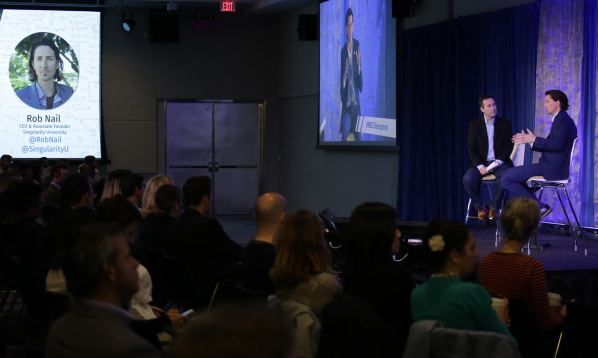Like a lot of Silicon Valley entrepreneurs, Rob Nail knows how to run a business and ride a wave. He says the skill sets are pretty similar.
Nail is CEO and co-founder of Singularity University, a Valley think tank that’s taught 18,000 participants from 111 countries in exponential change. He’s also a master of the big wave.
This is what he says you need to know about both: Every wave is different. Every day you’re a beginner. And every failure – at least those that don’t kill or maim – is a gift.
Nail spoke recently at #RBCDisruptors about the massive changes coming at us because of technology, the mindset needed for exponential change and how we can shape it. He helped launch the first-ever SingularityU Canada Summit last week, to advise large Canadian firms and governments on the disruptive power of technological change.
Here’s some of what he had to say:
If You Knew You Would Live to 120, What Would Your Retirement Strategy Look Like?
Nail believes this will become reality in the next 30 years, as advances in health technology continue to evolve exponentially. His young children may even live to double his life expectancy.
Singularity predicts that human longevity will change dramatically with the increased use of digital health checks, in which humans will access 150GB of their body’s data yearly, literally digitizing their physical selves. Through closer monitoring and preventative interventions, they want to “make 100 the new 60″.
What Does Singularity Advise Companies to Do to Shift Their Mindsets?
Embrace the crazy idea.
“If those crazy ideas just so happen to be the future of this business ten years from now, you need to set up a structure, a team or a process that will allow those to come in, or at least experiment with them in some way,” said Nail.
And this has to come from the top
Nail emphasized that the CEO has to directly support change and protect the individual or team that is experimenting with something new, different and ‘weird’.
One CEO that has embraced radical change is Former GE CEO Jeff Immelt. With such a hardware-heavy, industrial model, GE has become a leader in digitizing their business in order to prepare for the future. “Ultimately what I believe Jeff has built is a business that has longevity; he’s built resilience for that business,” said Nail.
Another company example? Hardware giant Lowe’s. Nail recounted an interesting story about their small innovation team that began collaborating with startups and experimenting in different areas of the business. One prototype to emerge was a multilingual robot, with inventory management system integration, designed to interact with customers on the sales floor.
Despite not having much, or any, support internally (except for the CEO), the robot got built and was eventually launched in-market at a San Jose store. This launch generated more publicity and press coverage than anything the company had seen in its entire 80-year history. “From then on, the CEO internally starts talking about Lowe’s as an ‘information and innovation business’,” explained Nail.
The Role of Failure
Nail expressed that the grind of the workforce beats us to be fearful of failure, as many of us need to work in order to survive. Similarly, most organizations get set up and develop this deep fear of failure – in that, if a project doesn’t work, people are reprimanded or fired.
Nail brings in surfing as a metaphor. “It’s going through those failures over and over again, and then the one time you hit it, it all makes sense and makes it that much more powerful. Those failures aren’t really failures, they’re all part of the learning.”
Nail believes that corporations have a responsibility to empower their employees with new skills to help them find their next path, even if that means leaving the company – without fear. “If you’re motivated by fear, you look for something stable, which often looks like the past,” said Nail, referencing Brexit and Trump.
Moving Forward
According to Nail, we require adaptability, mindset, tools, resources and a support ecosystem) to help us move at a faster pace.
“We are going to see a fundamental amount of change in every aspect of our lives, every business, every industry and society,” said Nail.
Where to start? Nail advises taking a moment to think about the future, the shape of the next 30 years and what we can do differently.
“It’s rare that any of us have time to look beyond the next project, the next quarterly numbers, or even the next election cycle,” said Nail.
“Remember that there is a fear of technology out there. However, it may be the strongest force for good.”
As Senior Vice President, Office of the CEO at RBC, John Stackhouse is responsible for interpreting trends for the executive leadership team and Board of Directors with insights on how these are affecting RBC, its clients and society at large. Prior to this, John was editor-in-chief of The Globe and Mail (2009-14), editor of Report on Business, the newspaper’s national editor, foreign editor and its foreign correspondent based in New Delhi, India (1992-99).






